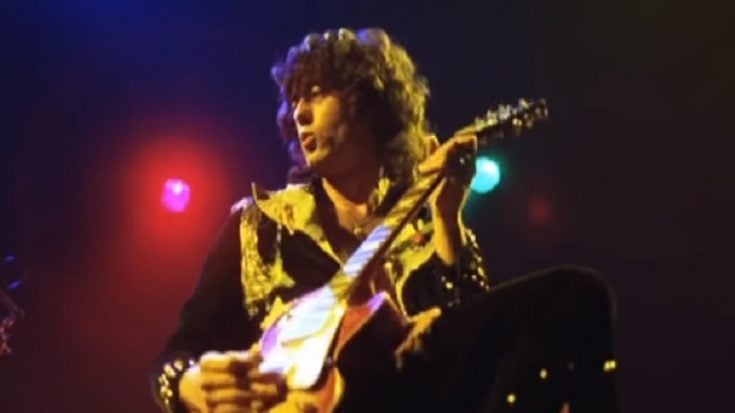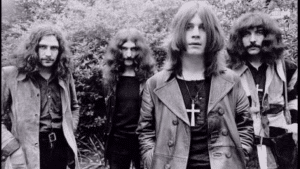5 Unstoppable Guitar Solos That Went Iconic

Jimmy Page- Gebunden96 /YouTube
Ah, guitar solos. The bolts of lightning in a bottle. The raging heartbeat of iconic rock songs. The sudden eruption of a guitarist’s creativity. Rock music’s best and most iconic guitar solos are the yardsticks that showcase the limitless possibilities of the guitar as an instrument.
A number of Iconic guitar solos became the defining moments in the careers of the guitarists who perform them. They become signature pieces, forever associated with the artist, and contribute significantly to their legacy.
They are the reason why there will never be a second Jimmy Page, Eddie van Halen, or Jimi Hendrix. They are the guitar gods of their times, as the others can only follow and emulate.
In a broader sense, iconic guitar solos are vital to the overall narrative of rock music. They punctuate the history of the genre, creating memorable touchpoints and serving as milestones that capture the essence of different eras.
These solos are like musical time capsules, transporting us back to the moments when they were first heard, and they continue to resonate with new generations of music enthusiasts, preserving the enduring legacy of rock music.
Step into these sonic machines and relive the greatness of these timeless thunderclaps that redefined rock.
5. “Stairway to Heaven” by Led Zeppelin (1977)
Led Zeppelin’s eight-minute epic that started about a wealthy woman buying herself into heaven was one of the most recognizable rock songs ever written. It was so ubiquitous that the frontman Robert Plant got tired of hearing and singing the song that made them a global household name.
And it is indeed ever-present as it was iconic; “Stairway to Heaven” is one of the best and most popular tracks from Led Zep’s most successful records, the unnamed fourth offering fans fondly called Led Zeppelin IV. This album is still one of the best-selling albums of all time to this day, just a few million copies shy from the mythical 40-million list.
View this post on Instagram
Apart from being one of the best works the band has ever written, “Stairway” also features one of Led Zep’s most iconic guitar works by none other rock deity Jimmy Page. The guitarist’s solo here is a masterpiece of emotional expression.
Page’s solo encapsulates a wide range of emotions, from melancholy and introspection to pure, unadulterated passion. It’s as if the guitar itself is telling a story, and the listener can’t help but be drawn into its narrative.
THE DEFINING MOMENT
In the slow, melodic part of the solo, Page uses a combination of bends, vibrato, and sustain to create a hauntingly beautiful atmosphere. This section is emotionally charged and evokes a sense of melancholy and reflection. It’s a prime example of Page’s ability to convey deep emotion through his guitar playing.
As the solo progresses, Page gradually builds up the intensity. Around the halfway point, he launches into a faster, more virtuosic section that includes rapid arpeggios, scale runs, and dynamic shifts. This sudden burst of energy is a defining moment, as it takes the listener on a journey from introspection to exhilaration.
The solo eventually reaches its climax with a flurry of notes and a dramatic bending of the guitar strings, which adds to the overall intensity of the performance. It’s a moment of pure musical ecstasy that showcases Page’s technical prowess.
4. “Hotel California” by Eagles (1971)
Another iconic song that defined a rock band. This title track from Eagles’ 1977 Hotel California will always be remembered for its’ harmonious guitar work, haunting and mysterious lyrics, and, of course, its memorable coda.
The guitar solo in “Hotel California” by the Eagles, performed by Don Felder and Joe Walsh, is often regarded as one of the most iconic solos in rock history. It was so good that it was voted by the readers of Guitarist as the best guitar solo of all time in 1998.
Don Felder & Joe Walsh…Live at the Capital Centre, March 1977. #theeagles #hotelcalifornia #donhenley #joewalsh #eagles #glennfrey #music #donfelder #rock #classicrock #rocknroll #timothybschmit #fleetwoodmac #guitar #randymeisner pic.twitter.com/OFzXHlitBt
— Rock Board (@musicislife877) March 11, 2022
The textured solo, created by the marriage of Felder’s and Walsh’s guitar work, perfectly complements the song’s haunting and mysterious atmosphere. But the iconic song almost didn’t happen when Felder, who came up with the song, played a different, improvised tune when they started recording.
During the recording session, when he spontaneously began improvising, Henley interrupted him and insisted that he replicate the demo precisely. Felder had to phone his wife and ask her to play the cassette demo over the phone to help him recall the original guitar part he had played.
THE DEFINING MOMENT
The masterpiece is taken to a whole new level when Walsh takes over with his fiery and expressive guitar work.
The transition from Felder’s melodic opening to Walsh’s more aggressive and dynamic style is a standout moment. Walsh’s guitar work injects a sense of urgency and intensity into the solo, creating a gripping contrast that mirrors the lyrical themes of the song.
The harmonious synchronization near the conclusion of the solo, neatly tying together the musical narrative, elicits a renewed sense of excitement, even in the most seasoned listener, resulting in a fresh wave of goosebumps. Listening to “Hotel California” will always take you on a haunting ride.
3. “Eruption” by Van Halen (1978)
You can’t create a guitar solo list without this song, or its guitarist Eddie Van Halen. “Eruption”, which started as a warm-up exercise Eddie used, is an instrumental solo that leads into their cover of The Kinks’ “You Really Got Me”. Both songs are from their self-titled debut album released in 1978.
Not merely a song but a blazing spectacle, “Eruption” served as a platform for Eddie Van Halen to display his pioneering technique, notably the two-handed tapping that he brought into prominence, shaping the landscape of the ’80s pop-metal genre. This solo truly erupted, causing seismic shifts in the fundamental conventions of rock guitar.
View this post on Instagram
In the Rolling Stone magazine Issue 1054, Van Halen explained that they recorded their debut album at Sunset Sound in Hollywood while gearing up for a weekend performance at the Whisky a Go Go. During a rehearsal, he was just practicing when the engineer, Donn Landee, coincidentally captured it on tape. It was never part of the initial plan to include it on the record. So, the version on the album was a complete accident, a serendipitous moment where the recording happened spontaneously.
The perfectionist guitarist can point out a mistake at the start of the song and probably cringes whenever he hears it. “Whenever I hear it, I always think, Man, I could’ve played it better,” Eddie admitted.
THE DEFINING MOMENT
The defining moment in the solo was also a defining moment in rock history. When Eddie introduced the two-handed tapping technique through “Eruption”, he rewrote the rules of guitar playing right before our ears.
Eddie Van Halen’s contribution to this song represented a monumental stride in the evolution of rock guitar. According to Jas Obrecht, the editor of Guitar Player magazine, as stated in the book Shredders!, “His playing, especially on the instrumental, “Eruption”, upped the game for everyone”.
“The technique of tapping the fingerboard had been around for decades, but it was sparsely practiced, and almost always as a novelty. Eddie brought finger tapping into mainstream rock’n’roll,” added.
2. “Comfortably Numb” by Pink Floyd (1980)
“Comfortably Numb” will always be David Gilmour’s finest work. This sublime track was from Pink Floyd’s influential rock opera The Wall, and remains one of their best-known songs.
The song was written by Gilmour and Roger Waters, who came up with the idea used in the album. The two musicians had to argue about what version should be used in the album before they decided to edit “Comfortably Numb” together.
David Gilmour’s solo on Pink Floyd’s 1979 track Comfortably Numb has been voted the Greatest Guitar Solo of All Time by listeners to @PlanetRockRadio in a new poll. pic.twitter.com/dX8hUib8ML
— Pink Floyd (@pinkfloyd) August 31, 2022
As it turned out, this marked the final songwriting collaboration between Waters and Gilmour. In 1985, Waters departed from Pink Floyd and was even taken aback by the band’s decision to continue without him.
Gilmour said in a Guitar World interview that he didn’t take much time creating the solo. “I just went out into the studio and banged out five or six solos. From there I just followed my usual procedure, which is to listen back to each solo and mark out bar lines, saying which bits are good.”
THE DEFINING MOMENT
Gilmour’s guitar solo in “Comfortably Numb” is one of those rare solos that transcends the confines of rock music and becomes a work of art in its own right. The gradual ascent toward the climax, where Gilmour’s guitar seems to weep with emotion, captures the very essence of the song’s lyrics.
The legendary guitarist takes over and tells the story himself as his guitar becomes the narrator. As the solo progresses, it takes the listener on a journey of introspection and longing. The solo’s emotional depth is palpable, and it’s impossible not to be moved by the way Gilmour’s guitar seems to emote.
When the second solo reaches its zenith, Gilmour’s guitar reaches out into the stratosphere with a series of soulful bends and sustained notes. It’s as if the entire song has been building to this climactic release of emotion. This moment is not just a display of technical skill; it’s a moment of pure catharsis, a musical exhalation of all the feelings the song has been building up.
1. “All Along the Watchtower” by Jimi Hendrix (1968)
“All Along the Watchtower” by Jimi Hendrix is an iconic song that gives shape to the brilliance of both Hendrix as a guitarist and the timeless quality of Bob Dylan’s songwriting.
Jimi took The Bard’s original and elevated it into an epic narrative with the power of his guitar. What’s more, In his solo for this song, the guitar visionary delivers an electrifying performance, replete with the distinctive sounds of the wah-wah pedal and feedback, solidifying its status as a pivotal element of psychedelic rock.
View this post on Instagram
Hendrix’s rendition of the song is a masterclass in guitar virtuosity. Dylan’s already compelling folk-rock composition transformed into phenomenal rock masterpiece. Hendrix’s intricate fingerpicking had a sense of controlled chaos that showcases his innovative approach to the instrument. The opening riff alone is instantly recognizable and serves as a testament to his enduring influence on rock guitarists across generations.
With bard penning the song, the song captured the spirit of the turbulent 1960s and Hendrix added his touch of foreboding as he searches for meaning in a chaotic world.
THE DEFINING MOMENT
Hendrix’s breathtaking guitar work in “All Along the Watchtower” is empowered by solo that certainly became the pinnacle not only of his performance, but also of the counterculture of the 60s.
The moment when the solo ignites is like a musical eruption, with Hendrix’s guitar becoming a voice of raw emotion and sheer virtuosity. It’s a sonic journey that takes the listener to new heights, with its soaring bends, rapid-fire licks, and the distinctive use of the wah-wah pedal creating a sense of controlled chaos.
This solo encapsulates Hendrix’s genius as a guitarist and his ability to convey a wide range of emotions through his instrument. It’s a moment of catharsis and intensity, leaving no one wondering why his work in “All Along the Watchtower” is considered one of the greatest guitar solos in rock history.
















